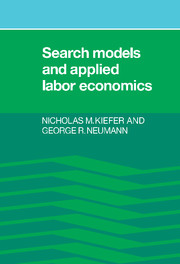Book contents
- Frontmatter
- Contents
- Preface
- 1 Introduction
- Part I Wages, reservation wages, and duration
- Part II Continuous-time models of duration
- 5 Earnings, unemployment, and the allocation of time over time
- 6 Choice or chance? A structural interpretation of individual labor market histories
- 7 Layoffs and duration dependence in a model of turnover
- Part III Applications
- Part IV Mobility and contracting
- Index
6 - Choice or chance? A structural interpretation of individual labor market histories
Published online by Cambridge University Press: 06 October 2009
- Frontmatter
- Contents
- Preface
- 1 Introduction
- Part I Wages, reservation wages, and duration
- Part II Continuous-time models of duration
- 5 Earnings, unemployment, and the allocation of time over time
- 6 Choice or chance? A structural interpretation of individual labor market histories
- 7 Layoffs and duration dependence in a model of turnover
- Part III Applications
- Part IV Mobility and contracting
- Index
Summary
Recently survival analysis has made its debut in econometrics as a technique for modeling the observed labor force experience of individuals over time. Although continuous-time theoretical models of optimal dynamic labor force participation are available, little use of them has been made in the empirical literature. Recent papers by Burdett et al. (1982), by Flinn and Heckman (1982) and by Olsen and Farkas (1982) are exceptions. Burdett et al. develop a continuous-time Markov decision model of an individual worker's labor force participation decision problem and use the model to interpret their empirical estimates of what can be regarded as “reduced form” relationships between rates of transition between states – employment, unemployment, and non-participation – and worker characteristics. Flinn and Heckman present a different but related participation model and discuss the problem of empirically identifying its “structure.” Finally, Olsen and Farkas suggest an econometric method of estimating the “structure” of continuous-time Markov chain models. This chapter makes three contributions. First, a general dynamic continuous-time discrete choice model is set down which includes those of all three papers as special cases. Second, the problem of identifying the structure of special cases of the model is studied. Third, the method suggested by Olsen and Farkas is used to estimate the structure of the Burdett et al. model.
In all three papers, “choice” is a dichotomous decision made by the individual from time to time to be in one of a finite number of mutually exclusive states.
- Type
- Chapter
- Information
- Search Models and Applied Labor Economics , pp. 109 - 138Publisher: Cambridge University PressPrint publication year: 1989



